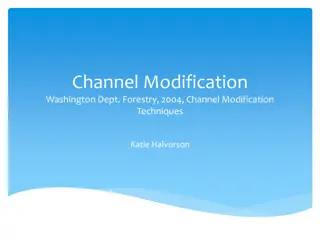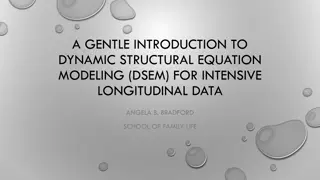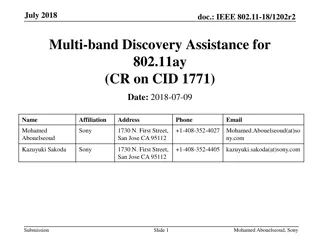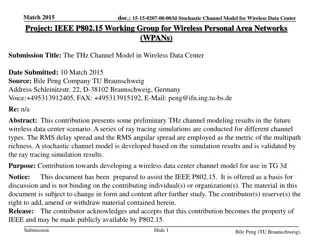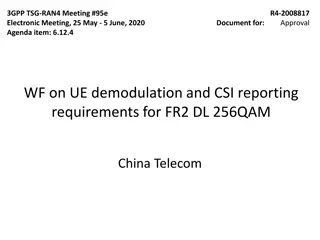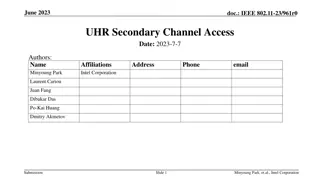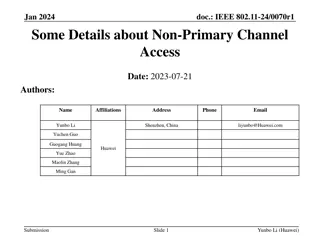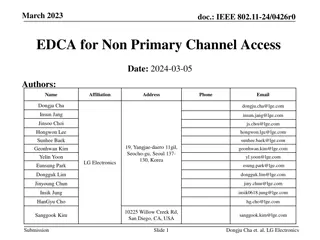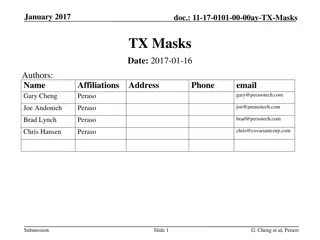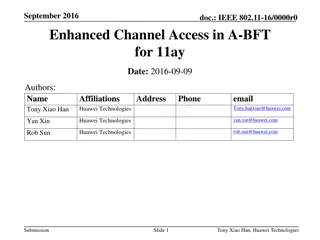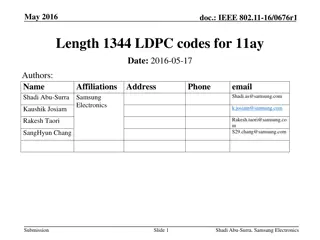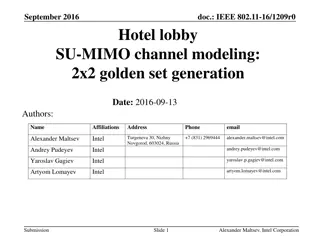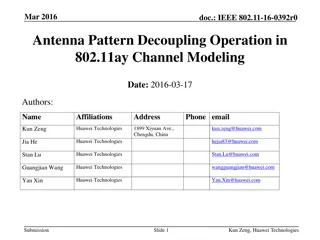
IEEE 802.11ay Channel Modeling Overview and Next Steps
Explore the discussion on the next steps for channel modeling in the 60 GHz indoor and outdoor scenarios for IEEE 802.11ay. Discover the challenges and requirements for extending existing channel models to mmWave and broadband signals. Understand the motivation, high-bandwidth needs, and empirical channel model properties crucial for advanced wireless system concepts.
Download Presentation

Please find below an Image/Link to download the presentation.
The content on the website is provided AS IS for your information and personal use only. It may not be sold, licensed, or shared on other websites without obtaining consent from the author. If you encounter any issues during the download, it is possible that the publisher has removed the file from their server.
You are allowed to download the files provided on this website for personal or commercial use, subject to the condition that they are used lawfully. All files are the property of their respective owners.
The content on the website is provided AS IS for your information and personal use only. It may not be sold, licensed, or shared on other websites without obtaining consent from the author.
E N D
Presentation Transcript
doc.: IEEE 802.11-15/1094 Overview and discussion about the next steps for 802.11ay channel modeling Date: 2015-09-15 Authors: Name Affiliatio ns Huawei Technologies Ilmenau University of Technology Address Phone email jianluo@huawei.com yan.xin@huawei.com mueller.robert@tu- ilmenau.de Jian Luo, Yan Xin Reiner Thom , Robert M ller, Diego Dupleich, Christian Schneider, Stephan H fner Submission Slide 1
doc.: IEEE 802.11-15/1094 Abstract In this presentation, the next steps for the channel modeling for 60 GHz indoor and outdoor scenarios are discussed. To find a useful model it is necessary to find out which approach is the best to combine the measurement and modeling for 802.11ay. Some challenges for the extension of the existing channel models to mmWave and broadband signals are demonstrated. Submission Slide 2
doc.: IEEE 802.11-15/1094 Outline Motivation Requirements for the 802.11ay channel model Channel Models Challenges in the modeling development Conclusion Submission Slide 3
doc.: IEEE 802.11-15/1094 Motivation ISM-band at 60 GHz Unlicensed and wide bandwidth available (up to 7 GHz) WLAN/WiGig (802.11ad) and WPAN (802.15.3c) Advanced system concepts define measurement and modelling requirements Massive MIMO/pencil beamforming large spatial bandwidth Adaptive or switched selection beamforming to mitigate shadowing Channel bonding large bandwidth Propagation channel Double directional measurements are needed to characterized the full channel Polarization is an important aspect High dynamic range are essential to measure the different propagation effects Channel characterization for different usage cases Submission Slide 4
doc.: IEEE 802.11-15/1094 Requirements for the TG.ay channel model High bandwidth up to 4 GHz Full polarimetric description Full 3D channel model description Antenna independent model - DoA and DoD - Beamforming capability - MIMO capability Time evolution - Beam Tracking Spatial consistency - Multi user capability Proper distinction between deterministic and stochastic channel contributions - - - - - - - Submission Slide 5
doc.: IEEE 802.11-15/1094 Empirical Channel Models Basic Properties Parameters extracted from the measurements (based on measurements) HRPE (High Resolution Parameter Estimation) necessary to remove the antenna pattern from the model parameters Approved procedure such in WINNER, COST and ITU models Open issues for broadband mmWave channel models No HRPE algorithms for the current mmWave measurements are available (Antenna element spacing smaller than /2 required) No broadband effects are included The channel is more deterministic due to directive antennas and bandwidth Long measurement time for directional measurements because there are no measurement arrays current available Consequently fewer measurement points with too high opening angles of the antennas for a statistical analysis Submission Slide 6
doc.: IEEE 802.11-15/1094 Deterministic Channel Models (1) Deterministic Model Based on fix geometry (Building, rooms or scenarios) Analysis mostly applied to particular situations A popular modeling method is ray tracing (map based models) The idea of a simple ray tracing model in 802.11ay How to extract the parameters for transmission, reflection and diffraction? (effective roughness model) How to include broadband effects? From measurements but it requires to meet some conditions Unambiguous assignment of the coefficients to geometry and materials Separation of the individual effects Submission Slide 7
doc.: IEEE 802.11-15/1094 Usage of the 60 GHz Entrance Hall Measurements to Extract Parameters for the Ray Tracer Submission Slide 8
doc.: IEEE 802.11-15/1094 Dual Polarimetric Ultra-Wideband Channel Sounder (DP-UMCS) RX Module TX Module PA min. 23 dBm LNA Step Gain : 35 dB H Pol. Attenuator CH 1 UWB H Pol. Switch Sounder TX 0 3.5 GHz 3.5 GHz - 10.5 GHz UWB Sounder RX 0 3.5 GHz 3.5 GHz - 10.5 GHz 56 - 66 GHz 56 - 66 GHz CH 2 V Pol. Step LNA Attenuator Gain : 35 dB V Pol. PA min. 23dBm Multiplier X8 Multiplier X8 Optical link Optical link 7 GHz Oscillator 7 GHz BW up to 10 GHz measurable bandwidth Maximum excess delay of 606 ns (180 m) in CS version 1 Dual polarization measurement capability 25 dB AGC (Automatic Gain Control) with 3.5 dB steps High instantaneous dynamic range: up to 75 dB Multi-Link and Massive MIMO capabilities Double directional measurements (with 1 TX and 2 RX) Submission Slide 9
doc.: IEEE 802.11-15/1094 Entrance Hall Scenario Dimensions: 7 x 25m x 9m Class and metal 3 different floors Submission Slide 10
doc.: IEEE 802.11-15/1094 Entrance Hall Scenario Entrance Hall of Zuse Bau at TU Ilmenau 1 Tx Positions (1 Tx in the ground floor) 9 Rx Positions (all in the ground floor) Tx 1 Rx 14 Rx 10 Rx 4 Rx 9 Rx 2 Rx 3 Rx 2 Rx 1 Rx 1 Submission
doc.: IEEE 802.11-15/1094 Measurement Set-Up Static access point scenario Tx: Located on the side of the wall Height from ground 2.5 m 30 HPBW of the antenna Rx: Located at several points in the hall Height 1.4m 30 HPBW of the antenna 2.8m + - Rx 1 5m Azimuth 0 C Rx 9 Rx 2 5m Rx 3 A - Rx 10 Azimuth 0 Tx X 5m + Rx 4 B Rx 14 Scanning at Tx and Rx stage via positioners Tx: Azimuth -90 ... 30 Elevation -90 30 Rx: Azimuth -180 30 90 90 150 Rx 12 Rx 13 Submission
doc.: IEEE 802.11-15/1094 Data Pre-processing No Calibration Noise floor estimation and removal Samples lower than the noise floor + 10dB are set to zero 2 ?,? ?,? ?,?,?,? if 10log10 ?,?,?,? 0 a.o.c. > NFdB+ 10 dB ?,? ?,?,?,? Submission
doc.: IEEE 802.11-15/1094 Power Angular Profile at Tx At single Rx beam HH VH 90 90 0 60 60 30 30 TX Elevation [ ] TX Elevation [ ] -5 0 0 -30 -30 -10 -60 -60 -90 -90 -90 -60 -30 0 30 60 90 -90 -60 -30 0 30 60 90 TX Azimuth [ ] TX Azimuth [ ] -15 HV VV 90 90 60 60 -20 30 30 TX Elevation [ ] TX Elevation [ ] 0 0 -25 -30 -30 -60 -60 -90 -90 -30 -90 -60 -30 0 30 60 90 -90 -60 -30 0 30 60 90 TX Azimuth [ ] TX Azimuth [ ] Submission
doc.: IEEE 802.11-15/1094 Power Angular Profile at Rx Power Angular Profile at Rx for different Polarizations 15 TX H - RX H TX H - RX V TX V - RX H TX V - RX V 10 5 0 Rx Power [dB] -5 -10 -15 -20 -25 -150 -100 -50 0 50 100 150 Rx Azimuth [ ] Submission
doc.: IEEE 802.11-15/1094 Power Delay Profile at single Rx and single Tx beam Power Delay Profile at Rx for different Polarizations 10 TX H - RX H TX H - RX V TX V - RX H TX V - RX V 0 -10 Rx Power [dB] -20 -30 -40 -50 50 100 150 200 250 Delay [ns] Submission
doc.: IEEE 802.11-15/1094 Deterministic Channel Models (2) To extract parameters for the ray tracer from the last 60 GHz entrance hall measurement campaign It doesn't work because the beamwidth of the used antenna is high 30 HPBW We cannot separate the geometrical structures We need a better 3D map of the scenario and a high gain antenna This increases the measurement time to several days per measurement point by the current measurement setup Submission Slide 17
doc.: IEEE 802.11-15/1094 Physical-Statistical Models (GBSCM, Hybrid Model) Combinations of deterministic and statistical model Widely accepted at standardization (3GPP, ITU, .) Extensions possible Next steps in the development 60 GHz channel model Extension of a 3GPP model to the new requirements for mmWave broadband systems Combined parametrization from ray tracing and measurements Future perspective: measurements with dual polarized antenna arrays Development of a HRPE for mmWave broadband systems Submission Slide 18
doc.: IEEE 802.11-15/1094 Conclusion/Discussion An overview on the different channel model types All this models can be used as the basis for the extension to mmWave and broadband signals A simple ray racing model may be good for indoor but not for outdoor? The most promising solution is a physical-stochastically model (GBSCM) Parametrization with ray tracing and measurements Next Steps Extension of the calibration AGC calibration for dual pol. waveguide systems Outdoor: Above roof top to street level measurements Development of an HRPE for broadband signals and antenna spacing greater than /2 Analysis of broadband effects in the channel and modeling methods Extension of the current physical-stochastically models Submission Slide 19




